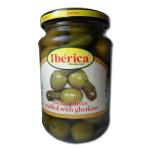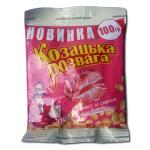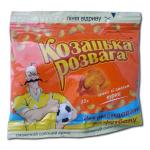
Other names for the additive (synonyms)
General Information
The food additive E621 – monosodium glutamate is a sodium salt naturally found in non-essential amino acids of glutamic acid. In the food industry, monosodium glutamate is used as a flavor enhancer.
Monosodium glutamate was first discovered and described in 1866 by the German chemist Karl Heinrich Leopold Ritthausen. Industrial use of additive E621 began in Japan, where for many centuries, extracts from seaweed rich in glutamic acid were used to improve the taste of food. In 1907, the additive was first obtained in pure form through carbohydrate fermentation, and its production was patented by a major Japanese corporation. Since then, industrial production and distribution of the additive have intensified. In 1947, monosodium glutamate began to be officially used in the United States as a flavor enhancer and later became widely used in Europe. Currently, more than one and a half million tons of monosodium glutamate are sold and used annually.
From the beginning of industrial production until the 1960s, additive E621 was produced from wheat gluten. Today, industrial monosodium glutamate is mainly obtained by bacterial fermentation. The raw materials include starch, sugar beet, sugar cane, or molasses. Yeast-type bacteria involved in fermentation include Brevibacterium, Arthrobacter, Microbacterium, and Corynebacterium.
Monosodium glutamate is present in the living cells of many organisms, mainly as part of proteins. Natural products containing free monosodium glutamate include yeast and soy extracts, soy sauce, legumes, some types of seaweed, mushrooms, chicken meat, beef, pork, and tomatoes. These products contain glutamic acid, which enters the body in its free form.
The action of additive E621 is based on enhancing receptor sensitivity because monosodium glutamate affects neurotransmitters, thereby increasing nerve channel conductivity and impulse strength. This provokes intensified taste sensations. The effect lasts about 20 minutes.
Additive E621 is highly soluble in water and does not require special storage conditions.
The chemical formula of monosodium glutamate is C5H8NNaO4.
Main characteristics of additive E621:
- Taste – none.
- Smell – odorless.
- Color – white.
- Consistency – solid crystalline powder, which dissociates into sodium cations and glutamate anions upon contact with water.
Effects on the Body
Benefits of Additive E621
Monosodium glutamate found in natural products has a beneficial effect on the digestive system:
- Stimulates the secretion of gastric juice;
- Improves intestinal peristalsis and motility;
- Strengthens immunity;
- Does not increase blood pressure like table salt (making natural monosodium glutamate suitable for people with hypertension);
- Neutralizes the harmful effects of ammonia, promoting its removal from the body;
- Helps treat central nervous system diseases;
- Contributes to the production of glutathione protein, which supports immunity.
Industrially produced monosodium glutamate used in the food industry provides no health benefits.
The EFSA Panel on Food Additives and Nutrient Sources added to Food (ANS) conducted a re-evaluation of glutamates in 2017 and recognized additive E621 as safe for human health when consumption does not exceed the established maximum allowable doses.
Risks of Additive E621
In small amounts, monosodium glutamate can be considered a safe additive. However, systematic consumption in large quantities may cause several side effects:
- Headaches;
- Stomach and intestinal problems;
- Weight gain (possibly obesity);
- Allergic reactions;
- Excessive sweating;
- Increased heart rate;
- Chest pain;
- Redness of the face and neck;
- General weakness.
The manifestation of these symptoms due to high consumption of monosodium glutamate is called the "Chinese restaurant syndrome," since this additive is used in large amounts in many dishes of Eastern cuisine.
Poisoning is also possible—monosodium glutamate can mask unpleasant odors and extend the shelf life of products, increasing the risk of consuming spoiled food disguised as normal.
A study conducted in Japan showed that monosodium glutamate causes vision deterioration by accumulating in the vitreous body and thinning the retina in test rats. The results were published in scientific journals in 2002. Rats received very high doses of the substance (10% and 20% of their daily diet) over a long period. Low doses did not cause vision deterioration. However, later data indicated that monosodium glutamate accumulates in the eye lens and leads to early eye diseases.
Continuous consumption of large doses of additive E621 leads to liver damage. Consumption of various vegetables and fruits may reduce this effect. For example, one study showed a positive effect of grape seed extract on liver recovery after monosodium glutamate intake.
Another study, published in the medical journal PubMed Central, also emphasizes that certain plant products reduce the negative effects of monosodium glutamate on the liver.
According to the EFSA Panel on Food Additives, the group acceptable daily intake for glutamates (additives E620–E625) is set at 30 mg/kg body weight per day.
Uses
In the food industry, additive E621 is used to enhance the flavor of:
- Seasonings;
- Bouillon cubes;
- Meat products – sausages, frankfurters, minced meat, hot dogs;
- Sauces, ketchups, mayonnaises;
- Canned and frozen semi-finished products;
- Potato chips;
- Fast food;
- Semi-finished products – frozen pancakes, chebureks, cutlets;
- Fish, meat, and fruit preserves;
- Crackers and snacks.
Monosodium glutamate makes the taste of the product as vivid as possible. Additive E621 also inhibits the growth of harmful microorganisms, extending the shelf life of the product.
The maximum permissible dosage of additive E621 in the food industry is 1% of the mass of solid products or 0.3% of liquids containing monosodium glutamate. Manufacturers do not exceed these limits; otherwise, the additive will only spoil the taste of the food.
In Japan, flavor enhancer E621 is believed to enrich dishes. In Vietnam, monosodium glutamate is called “onion salt.” In China, it is used as a “flavor seasoning.”
Monosodium glutamate is also used in cosmetics. It is added to:
- Facial skin care products;
- Scented emulsions and creams;
- Hair and body conditioners.
In the cosmetics industry, monosodium glutamate derived from coconut acid is used. This substance has softening properties, maintains pH balance, strengthens the skin’s lipid layer, reduces sensitivity, cleanses the epithelium, and helps prevent skin dryness.
Legal Status
Manufacturers are required to indicate the presence of monosodium glutamate in the product composition. At the same time, additive E621 is allowed in almost all countries worldwide.



